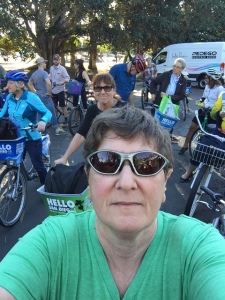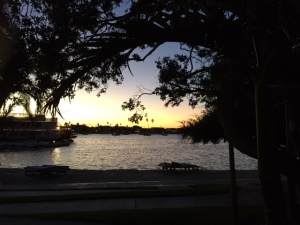There were some really great sessions on the final day of the Bicycle Tourism Network conference. Even if a session was not directly related to our needs, there were a lot of takeaways I found useful.
The first session by Norma Nickerson and Ginny Sullivan, who are also two of my new favorite people by the way, was on the importance of giving tourism marketing organizations (DMOs or destination marketing organizations) numbers that help make a compelling case for economic development support. Montana is in a really fortunate position because they have the Institute for Tourism and Recreation Research at The University of Montana (of which Norma is the director), and they’ve been doing all sorts of studies that support investing in infrastructure and other things in the state. Ginny is Director of Travel Initiatives at Adventure Cycling Association. She was so supportive and excited about what Angie and I are hoping to do.
One key point the two made in their presentation was the importance, when you are trying to use data to get support, of using data that has been gathered by someone else. It’s vital to have it shown as unbiased data. Another was the value of pointing out to marketing organizations or funding sources that a cyclist crossing the state will need to make more stops than motorists because they move more slowly so they probably have to make more overnight stops. Quite good– since the Montana research showed that the average cyclist spends about $75 a day, whereas the average visitor spends about $58 a day.
It’s also important to be aware, and others have also pointed this out this week, that people who are bicycle touring will often be interested in other attractions, including historical sites, wildlife, breweries and hiking.
There were a couple of good snippets from the session Mountain Bike Tourism: What Mountain Bikers Want. It was led by Mike van Abel of IMBA (International Mountain Bicycling Association). He noted that mountain bikers tend to have higher average household incomes than other bikers and also have children, so building or promoting family attractions is important. Mountain bikers like to eat locally and love beer, so this must be available if you want people to come to mountain bike! Mike brought up two speakers. Aaron Hautala of Cayuna, Minnesota, and Kalene Griffith of Bentonville, Arkansas. We’d met Kalene at the interactive discussion on the first day and were so impressed with what she had done promoting mountain biking in a region we had no idea was such a hotbed for the sport. She was great, but Aaron was amazing. He was talking about what had been done in his region to turn miserable open-pit mining areas into what he called Thematic Adventuring. The mines had provided raw materials that he noted had helped the country win World War I, and brought home the importance of having a story to tell that goes beyond “this is a great trail.”
There were a few good pointers that I took away from the first breakout session I went to, European Perspective on Cycling: What We Can Learn from the Success of the European Cycling Tourism Industry? This was a session presented by Theo Jorna of Hicle/Holcus Buiten BV. He talked about the importance of branding and also had some sort of how-tos about how to develop cycling tourism and what needs to be in a business plan.
For developing cycling tourism Theo listed the following:
- Attractions
- Routes that are comfortable, well signed, attractive and safe
- Amenities including bike shops, beer, food and lodging
- Tourists
- Promotion, including PR, advertising and social media, as well as getting the government and local businesses on board.
For the business planning, he emphasized:
- What is your target group?
- What is to be done?
- What are the costs?
- What is your time frame?
- What results are you looking for?
- How do you measure them?
- Who are your partners?
I thought these were some useful pointers, and there were some other details of which I made note for our planning purposes.
Angie and I had split off to attend separate sessions in order to maximize our learning, so we met up for lunch, but then split up again for the afternoon sessions too.
The session on social marketing was really useful. The presenters for this session were: Caitlyn Hassler (Travel Montana), Andrea Parrott (RAGBRAI), and Katy Clair (Travel Oregon). I learned about the value of getting influencers to talk about your brand/event/place, including how to vet them to make sure they can be beneficial to your marketing. I also learned a little bit about unique campaigns but I need to learn more about it. At least I already knew about hashtags!
My final session for the day was a mobile session. We got to go out on Decobikes, the city’s version of Bcycle, for a little ride led by Megan Ramey of Bikabout, assisted by Ellee Thalheimer (Into Action Publications), and Shea Mayer (Fitz & Follwell). The main point was to sample some local ice cream from the Baked Bear and some beer flights from Draft. We rode about three miles. The most interesting part of the ride was just having a chance to chat with several of the other people participating in the conference, including Ellee (named above) and Laura Willis from Gotham Bicycle Tours, as well as some people I’d met previously during the week, like Andrew Broan of HE Travel. I also got to talk for a while to Norma Nickerson, who is a very cool woman.
The “session” ended up lasting a lot longer than we expected, and we got to watch the sun set over the ocean as we finished up at Draft.
The conference was a resounding success as far as I’m concerned. We learned so much but we also got to meet some really great people, some of whom gave us pointers or paths of support as we move forward. Some people were just plain cool and fun to meet.
I have to give some shout-outs here to a bunch of people who either gave us good insights when we met them, or were just plain fun or cool to meet:
- Andrew Broan of HE Travel
- Laura Crawford and Russ Roca of Path Less Pedaled
- Kalene Griffith of Visit Bentonville
- Arlen Hall, Saara Snow and Ginny Sullivan of Adventure Cycling Association
- Judy Hector of City of Sierra Vista, AZ
- John Hutchinson of Primal
- Nathalie Lauzon and France Thiboutot of Velo Quebec/Grand Tour
- Linda McKenna Boxx of Great Allegheny Passage
- Sara Petyk of Bike the GAP
- Maria Elena Price of Experience Plus
- Mina Thorgeson of Ridgeland Tourism Division (organizer of the Natchez Trace Century Ride)



I can think of few better excuses to go for a ride than to sample local ice cream! That’s my kind of party!
I can feel your momentum and am cheering you on!
We kind of agree but I have to admit I was rather disappointed in the ice cream, but we are such snobs about it!